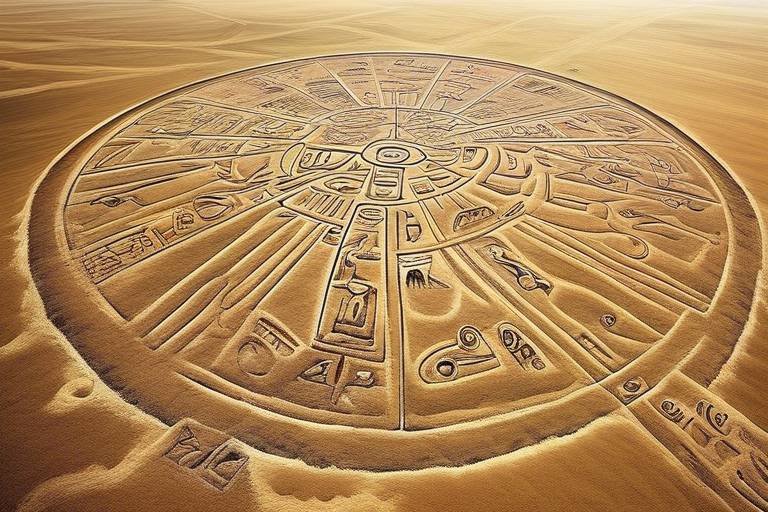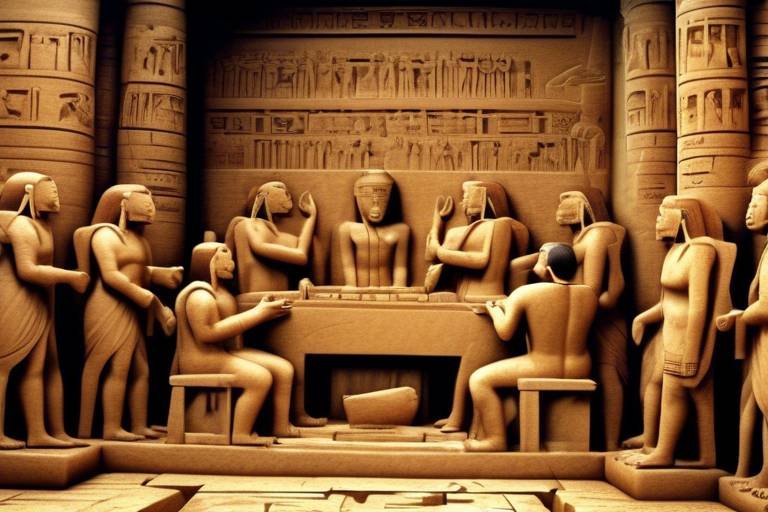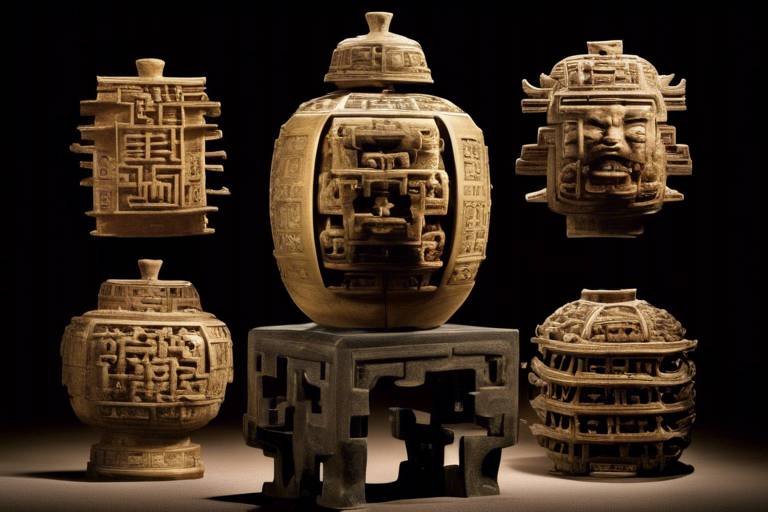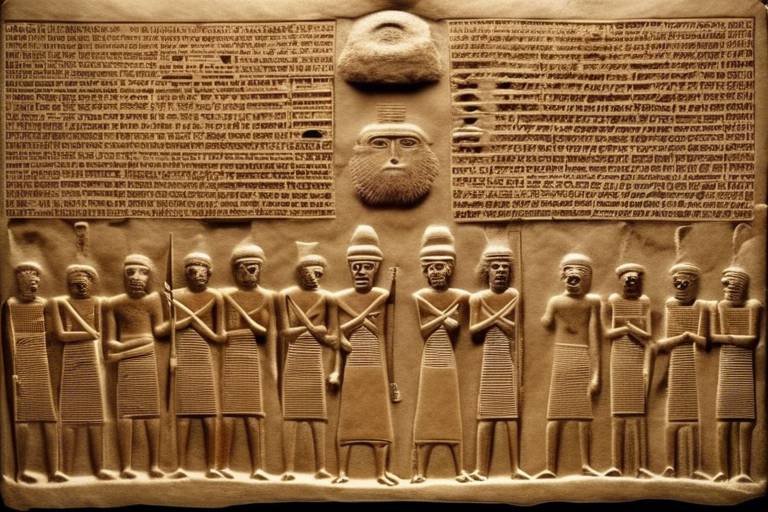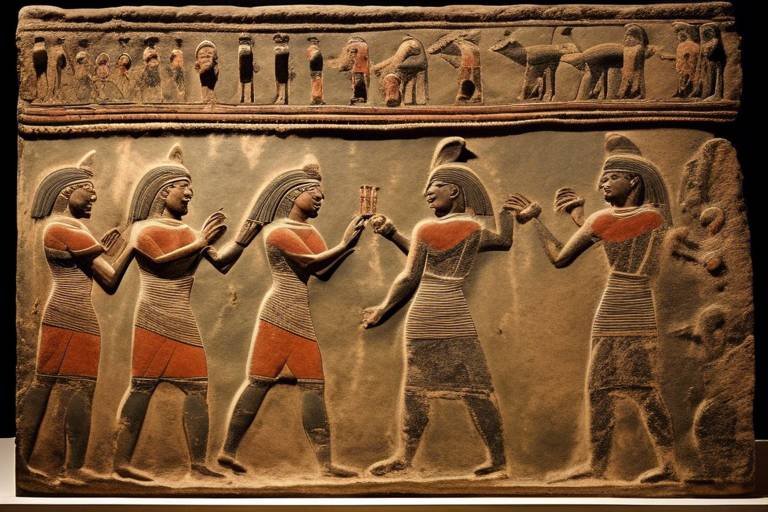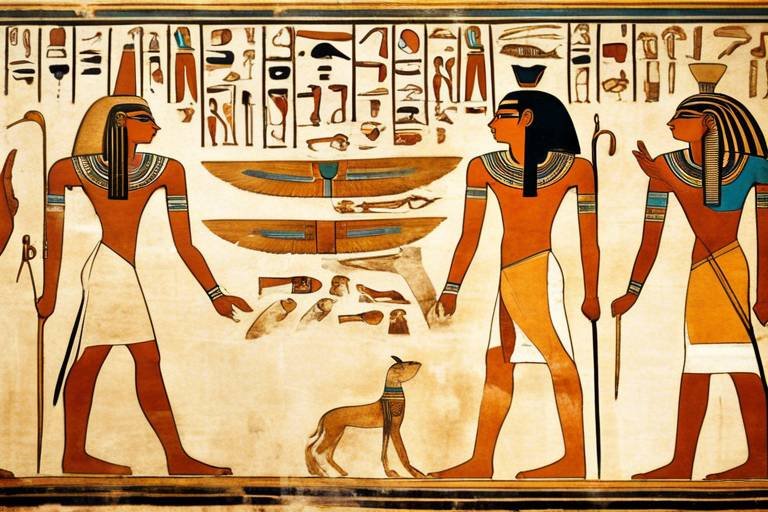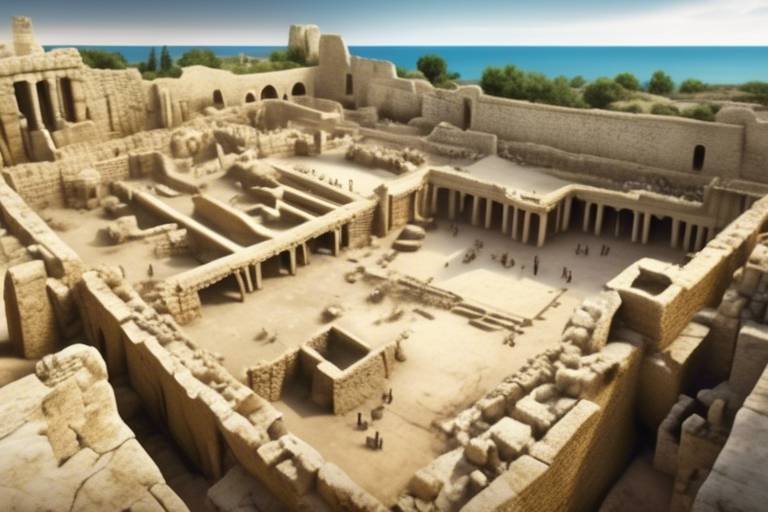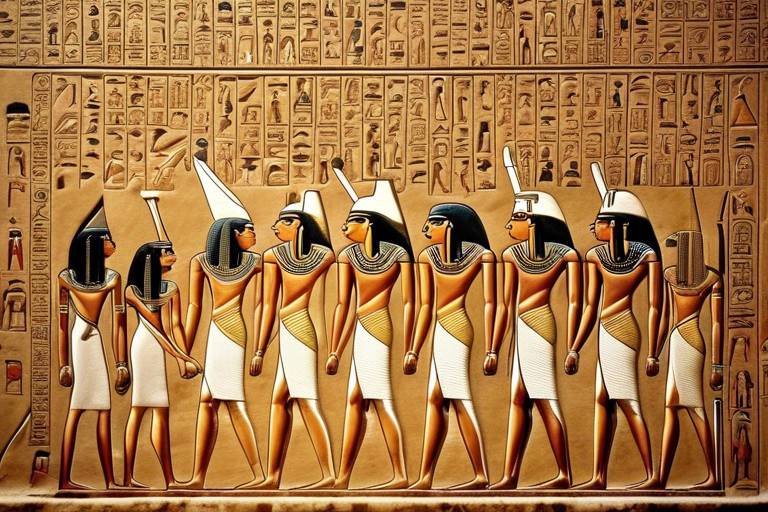The Lost City of Pompeii - Rediscovering Ancient Life
Have you ever wondered what it would be like to step back in time and explore an ancient Roman city frozen in the moment of a catastrophic volcanic eruption? Well, the lost city of Pompeii offers just that - a unique opportunity to rediscover ancient life and immerse yourself in the history, architecture, art, and culture of a civilization long gone.
As you wander through the ruins of Pompeii, you can't help but be amazed by the sheer magnitude of what once was a thriving city. The history of Pompeii dates back to its founding as a small settlement in the 7th century BC, eventually growing into a bustling metropolis by the time of its destruction in 79 AD. The eruption of Mount Vesuvius not only buried the city under layers of ash and pumice but also preserved it for centuries to come.
The architecture of Pompeii is a testament to the ingenuity and advanced engineering skills of the ancient Romans. From the intricate mosaics adorning the floors of villas to the well-preserved amphitheater where gladiatorial games were once held, every corner of Pompeii tells a story of a civilization ahead of its time.
Art and culture flourished in Pompeii, as evidenced by the stunning frescoes depicting scenes of daily life, mythological tales, and religious ceremonies. The colorful mosaics that adorn the floors of houses and public buildings offer a glimpse into the artistic prowess of the city's inhabitants, showcasing their attention to detail and aesthetic sensibilities.
Life in Pompeii was vibrant and diverse, with a complex social structure, bustling economy, and rich religious practices. From the temples dedicated to various gods and goddesses to the bustling markets where merchants sold their wares, Pompeii was a microcosm of ancient Roman society, offering a glimpse into the daily lives of its residents.
Preserving the archaeological site of Pompeii is a monumental task that requires careful planning, innovative techniques, and ongoing conservation efforts. The challenges of protecting the ruins from natural elements, wear and tear, and human impact are met with dedication and expertise to ensure that future generations can continue to learn from and appreciate this invaluable piece of history.
Modern-day tourists flock to Pompeii to experience firsthand the wonders of this ancient city, guided by knowledgeable experts who bring its history to life. From the haunting plaster casts of the volcano's victims to the grandeur of the Forum and the thermal baths, visitors are transported back in time to witness the legacy of Pompeii up close.
Ongoing research and discoveries in Pompeii continue to shed new light on the daily lives, customs, and beliefs of its ancient inhabitants. Scientific analyses of artifacts, architectural remains, and human remains provide valuable insights into the past, enriching our understanding of this remarkable archaeological site.
The legacy of Pompeii extends far beyond its ancient walls, influencing art, literature, popular culture, and historical studies to this day. The timeless fascination with this lost city speaks to its enduring impact on contemporary society, serving as a reminder of the fragility and resilience of human civilization.

History of Pompeii
The history of Pompeii is a captivating tale of rise and fall, of prosperity and tragedy. Founded in the 6th century BC by the Oscans, Pompeii flourished as a bustling Roman city near the Bay of Naples. Its strategic location and fertile lands contributed to its growth as a commercial hub, attracting merchants, artisans, and wealthy residents.
However, Pompeii's fate took a dramatic turn on that fateful day in 79 AD when Mount Vesuvius erupted, burying the city under a thick layer of volcanic ash and pumice. The catastrophic event not only destroyed Pompeii but also preserved it in a time capsule, offering modern archaeologists a unique glimpse into ancient Roman life.
For centuries, Pompeii lay forgotten beneath the earth until its rediscovery in 1748 by Spanish engineer Rocque Joaquin de Alcubierre. The excavation of the site unearthed well-preserved buildings, artifacts, and human remains, shedding light on the daily routines, customs, and architecture of this ancient city.
The ruins of Pompeii serve as a poignant reminder of the fragility of human existence and the enduring power of nature. The city's tragic history continues to captivate visitors from around the world, drawing them into a narrative of loss, resilience, and the inexorable march of time.

Architecture of Pompeii
The architecture of Pompeii stands as a testament to the ingenuity and sophistication of ancient Roman engineering. Walking through the streets of this preserved city, one can marvel at the intricately designed buildings, temples, and public spaces that showcase the urban planning expertise of the Romans. The layout of Pompeii reflects a well-organized city with its grid-like streets, grand villas, public baths, and amphitheaters, all constructed with meticulous attention to detail.
One of the notable features of Pompeii's architecture is the use of materials such as volcanic stone, marble, and terracotta, which not only added to the city's aesthetic appeal but also ensured durability against the test of time. The buildings in Pompeii vary in size and purpose, from humble dwellings to elaborate mansions adorned with colorful frescoes and intricate mosaics that depict scenes from daily life, mythology, and nature.
The Forum of Pompeii, a central public square surrounded by important governmental and religious buildings, served as the heart of the city's social and political life. The amphitheater, capable of seating thousands of spectators, hosted gladiatorial contests and other public spectacles, showcasing the entertainment culture of ancient Pompeii.
The advanced architectural techniques employed in Pompeii, such as the use of arches, vaults, and columns, not only added structural stability to the buildings but also contributed to the overall aesthetic beauty of the city. The innovative water supply and drainage systems further highlight the engineering prowess of the ancient Romans, ensuring a comfortable and functional living environment for the inhabitants of Pompeii.
Exploring the architectural wonders of Pompeii offers a glimpse into the past, allowing visitors to appreciate the skill and artistry of the craftsmen who constructed this ancient city. The buildings of Pompeii not only serve as physical remnants of a bygone era but also as windows into the daily lives and aspirations of its residents, immortalized in stone and mortar for future generations to admire and study.

Art and Culture in Pompeii
Art and culture flourished in Pompeii, reflecting the vibrant and diverse society of the ancient city. The archaeological excavations have unveiled a treasure trove of artistic expressions, from intricate mosaics to beautifully preserved frescoes that adorn the walls of villas and public buildings. These artworks provide valuable insights into the daily lives, beliefs, and traditions of Pompeii's inhabitants, showcasing their sophisticated aesthetic taste and cultural sophistication.
The art in Pompeii is not merely decorative but serves as a window into the past, revealing stories of mythology, history, and daily activities. The House of the Vettii, for example, boasts stunning frescoes depicting scenes from Greek mythology, offering a glimpse into the artistic preferences and cultural influences of the elite residents. Similarly, the Villa of the Mysteries features a captivating series of frescoes that depict a mysterious Dionysian ritual, sparking debates among scholars about its symbolic meanings.
Moreover, the intricate mosaic floors found in Pompeii's houses and public buildings showcase the skill and craftsmanship of ancient artisans. These intricate designs, often depicting geometric patterns, animals, or mythological figures, highlight the importance of art in everyday life and the attention to detail that characterized Roman artistic production.
Aside from visual arts, Pompeii also boasted a rich cultural scene, with theaters, amphitheaters, and public baths serving as hubs of entertainment and social interaction. The amphitheater of Pompeii, one of the oldest surviving Roman amphitheaters, hosted gladiatorial combats and other spectacles that were integral to the city's social fabric.
Religious practices also played a significant role in Pompeii's culture, as evidenced by the numerous temples dedicated to various deities, such as the Temple of Apollo and the Temple of Isis. These religious structures, adorned with statues and altars, offer valuable insights into the spiritual beliefs and practices of the ancient Pompeians.
In essence, the art and culture of Pompeii provide a glimpse into a world long gone, yet remarkably preserved through the ashes of Vesuvius. From the intricate artworks adorning the walls of villas to the bustling theaters and temples, Pompeii's cultural heritage continues to captivate and inspire visitors from around the globe, showcasing the enduring legacy of a civilization lost in time.

Life in Pompeii
The bustling city of Pompeii was a vibrant hub of activity, filled with a diverse population engaged in various aspects of daily life. From the wealthy elites to the common laborers, Pompeii was a microcosm of ancient Roman society, offering a glimpse into the social structure and cultural practices of the time. The city's economy thrived on trade, agriculture, and craftsmanship, with markets bustling with merchants selling goods from near and far. Religious practices played a significant role in Pompeii, with temples dedicated to various gods and goddesses scattered throughout the city, reflecting the spiritual beliefs of its inhabitants.
The streets of Pompeii were alive with the sounds of chatter, footsteps, and the clatter of horse-drawn chariots, showcasing the daily hustle and bustle of urban life. Public baths, theaters, and amphitheaters provided entertainment and leisure activities for the residents, fostering a sense of community and shared experiences. The colorful frescoes adorning the walls of homes and public buildings depicted scenes of everyday life, mythological tales, and religious ceremonies, offering a glimpse into the artistic expressions of Pompeii's inhabitants.
Family life was central to the social fabric of Pompeii, with households ranging from modest dwellings to grand villas adorned with intricate mosaics and lush gardens. Women played essential roles in managing the household and raising children, while men engaged in various professions and civic duties. Slavery was also prevalent in Pompeii, with enslaved individuals performing a range of tasks, from domestic work to skilled labor, shaping the economic landscape of the city.
Despite the vibrant and bustling nature of Pompeii, the city was also vulnerable to natural disasters, as evidenced by the catastrophic eruption of Mount Vesuvius in 79 AD. The sudden devastation brought an abrupt end to the lives of Pompeii's inhabitants, preserving the city in a time capsule that would be rediscovered centuries later, offering a poignant reminder of the fragility of human existence and the enduring legacy of this ancient civilization.

Preservation Efforts
Exploring the ruins of Pompeii offers a glimpse into the daily life of an ancient Roman city frozen in time by a catastrophic volcanic eruption. Discover the history, architecture, art, and preservation efforts of this remarkable archaeological site.
Preserving the ancient city of Pompeii is a monumental task that requires careful planning and innovative techniques. The site faces numerous challenges, including environmental factors, visitor impact, and the passage of time. Archaeologists and conservationists work tirelessly to protect and maintain the integrity of the ruins for future generations.
One of the key preservation efforts in Pompeii is the ongoing structural reinforcement of buildings to prevent collapse. With many structures damaged by the volcanic eruption and subsequent weathering, experts use advanced engineering methods to stabilize walls, roofs, and foundations. This ensures that the architectural heritage of Pompeii remains intact.
In addition to structural conservation, experts employ scientific methods to analyze and protect the delicate frescoes, mosaics, and artifacts found within the ancient city. Advanced imaging techniques, such as laser scanning and digital mapping, help document and monitor the condition of these priceless cultural treasures. Specialized cleaning and restoration techniques are also used to remove dirt, pollutants, and biological growth without causing harm to the original materials.
Furthermore, conservation efforts extend beyond the physical aspects of Pompeii to include educational programs and community engagement. By raising awareness about the importance of heritage preservation, local authorities and international organizations collaborate to promote sustainable tourism practices and responsible visitor behavior. Through guided tours, interactive exhibits, and workshops, visitors are encouraged to appreciate and respect the historical significance of Pompeii.
Overall, the preservation efforts in Pompeii represent a harmonious blend of scientific expertise, cultural stewardship, and public outreach. By safeguarding the ancient city's legacy, we ensure that future generations can continue to explore and learn from this extraordinary archaeological site.

Tourism and Visitor Experience
When it comes to experiencing the ancient marvels of Pompeii, modern-day tourists are in for a treat. Walking through the cobblestone streets and exploring the well-preserved buildings, visitors can truly immerse themselves in the daily life of this ancient Roman city. Guided tours offer insightful narratives, bringing the ruins to life with stories of the past. The amphitheater, forum, and baths are among the must-see attractions that showcase the grandeur and sophistication of Pompeii's architecture.
For those seeking a more in-depth understanding, museums within the archaeological site display artifacts, tools, and artwork recovered from the ruins, providing a closer look at the daily objects used by Pompeii's inhabitants. These exhibitions offer a glimpse into the art and culture of the ancient city, shedding light on the customs and traditions of its people.
Visitors can also witness ongoing preservation efforts firsthand, observing the meticulous work of archaeologists and conservationists dedicated to safeguarding Pompeii's legacy. Interactive exhibits and multimedia installations further enhance the visitor experience, offering a multi-sensory journey through time.
Exploring Pompeii is not just a sightseeing adventure but a profound encounter with history and human resilience. The city's tragic fate serves as a poignant reminder of the impermanence of civilizations, urging us to appreciate and learn from the past while contemplating our own legacy in the present.

Ongoing Research and Discoveries
In the realm of Pompeii archaeology, ongoing research and discoveries continue to unveil new layers of insight into the ancient city's history and inhabitants. Scientists and archaeologists are constantly unearthing artifacts, conducting scientific analyses, and exploring untouched areas of Pompeii to expand our knowledge of this fascinating site. Through meticulous excavation and advanced technology, researchers are able to piece together the puzzle of daily life in Pompeii before the catastrophic eruption of Mount Vesuvius.
One of the significant ongoing research projects in Pompeii focuses on the study of human remains found within the city. By analyzing skeletal remains, DNA samples, and burial practices, scientists aim to understand the demographics, health conditions, and social structures of Pompeii's population. These findings provide valuable insights into the lives of ancient Romans and how they coped with various challenges and diseases prevalent during that era.
Moreover, recent discoveries in Pompeii have shed light on the city's economic activities, trade networks, and cultural exchanges with other regions. Excavations of commercial areas, marketplaces, and artisan workshops have revealed the intricate economic system of Pompeii and its connections to the wider Roman world. Through the examination of trade goods, coins, and inscriptions, researchers can reconstruct the commercial dynamics of this bustling ancient city.
Additionally, ongoing research efforts in Pompeii extend to the exploration of domestic spaces, public buildings, and religious sites to uncover hidden treasures and untold stories. The meticulous documentation of architectural features, decorative elements, and inscriptions provides clues about the beliefs, rituals, and social practices of Pompeii's diverse population. By piecing together these fragments of the past, researchers aim to create a comprehensive picture of life in Pompeii before tragedy struck.
As technology advances and interdisciplinary collaborations flourish, the field of Pompeii studies continues to evolve, offering fresh perspectives and innovative methodologies for investigating this archaeological marvel. Through a combination of traditional excavation methods, scientific analyses, and digital reconstructions, researchers are pushing the boundaries of knowledge and unraveling the mysteries of Pompeii's past. The journey of discovery in Pompeii is far from over, promising more surprises and revelations for generations to come.

Legacy of Pompeii
When we think of the legacy of Pompeii, we are reminded of a city frozen in time, a snapshot of ancient life preserved for eternity. The ruins of Pompeii have not only captivated archaeologists and historians but also inspired artists, writers, and filmmakers for centuries. The legacy of Pompeii transcends its tragic history and offers a window into the past that continues to intrigue and educate us today.
One of the most significant aspects of Pompeii's legacy is its impact on art and literature. The vivid frescoes, intricate mosaics, and poignant sculptures unearthed from the ashes of Vesuvius have influenced countless artists throughout history. From Renaissance painters to modern-day creators, the art of Pompeii has left an indelible mark on artistic expression, serving as a timeless source of inspiration and admiration.
Furthermore, the excavation and preservation efforts at Pompeii have set a precedent for archaeological practices and heritage conservation. The meticulous work of uncovering and safeguarding the ancient city has established protocols and standards that guide similar projects around the world. Pompeii's legacy in preservation serves as a testament to the importance of protecting our shared cultural heritage for future generations.
On a cultural level, Pompeii's legacy extends to popular culture and entertainment. The dramatic story of the city's destruction has been retold in numerous books, films, and documentaries, captivating audiences with its blend of history and tragedy. Pompeii's legacy in popular culture not only keeps the memory of the city alive but also sparks curiosity and fascination with the ancient world among audiences of all ages.
Moreover, Pompeii's legacy serves as a cautionary tale about the unpredictability of nature and the fragility of human civilization. The sudden and catastrophic eruption of Mount Vesuvius that buried Pompeii serves as a stark reminder of our vulnerability in the face of natural disasters. The legacy of Pompeii prompts us to reflect on our own preparedness and resilience in the wake of potential calamities, urging us to learn from the past to safeguard our future.
Frequently Asked Questions
- What is the history behind the lost city of Pompeii?
The city of Pompeii was a thriving ancient Roman city near modern-day Naples, Italy. It was tragically buried under volcanic ash and pumice after the eruption of Mount Vesuvius in 79 AD, preserving it for centuries.
- How was Pompeii rediscovered?
Pompeii was rediscovered in 1748 by Spanish military engineer Rocque Joaquin de Alcubierre. Excavations began in the 18th century, uncovering the remarkably preserved ruins that provide valuable insights into ancient Roman life.
- What can visitors expect to see in Pompeii?
Visitors to Pompeii can explore well-preserved streets, houses, temples, baths, theaters, and even the famous plaster casts of victims frozen in their final moments. The site offers a unique window into ancient Roman civilization.
- How is Pompeii being preserved?
Preservation efforts in Pompeii involve a combination of structural reinforcements, monitoring systems, and ongoing restoration projects to protect the fragile ruins from natural elements and human impact, ensuring its survival for future generations.
- What ongoing research is being conducted in Pompeii?
Ongoing research in Pompeii includes archaeological excavations, scientific analyses of artifacts, and interdisciplinary studies to uncover new discoveries about the city's inhabitants, culture, and daily life, enriching our understanding of this ancient civilization.



